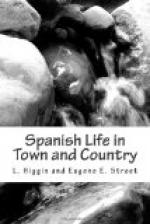All the town outside these barriers has arisen since; the magnificent viaduct across the Calle de Segovia, the Markets, the Parque de Madrid, the Hippodrome, the present Plaza de Toros, all are new. The old Bull Ring stood just outside the Alcala Gate, and all beyond it was open country; no casas palacias along the Fuente Castellana, no Barrio Salamanca. Madrid has, however, always been a cheerful, noisy, stirring city, full of life and the expression of animal spirits. In days not so very long past the streets were filled with picturesque costumes of the provinces, with gaily decorated mules and donkeys carrying immense loads of hay or straw, or huge nets filled with melons or pumpkins, almost hiding everything but the head and the feet of the animal; or a smart-looking “Jacket” man from the country districts would go whistling by, Asturians, Murcians, Gallegos, gypsies, toreros in their brilliant traje Andaluz—always to be recognised by their tiny pigtails of hair, and by their splendidly lithe and graceful carriage—all these jostling, singing, chaffing each other, while the jingling bells on innumerable horses, mules, donkeys, rang through the sunlit air, and made the Puerta de Sol and the streets branching from it a constant scene of life and gaiety. Now and then would come the deep clang of the huge bell of the draught oxen, drawing their Old-World carts, often with solid discs of wood for wheels, while the women of the lower class sported their brilliantly embroidered Manila shawls, chattered, and fluttered their gaily-coloured fans just like the other senoritas. Mantillas, even then, were only to be seen on old ladies; but the smart little velo coquettishly fastened with a natural flower adorned all the young girls—French millinery, which never suits a Spanish face, being kept for the evening paseo. It is a pity these national costumes have gone out of fashion. A Spanish girl with velo and fan is something quite superior to the same fascinating young person dressed after the style of Paris—with a difference; for there is always a difference.
[Illustration: OUTSIDE THE PLAZA DE TOROS, MADRID]
Madrid, in fact, is becoming cosmopolitan, and is little to be distinguished from other capitals, except in the barrios bajos on the national fiestas, and wherever the country people, as distinguished from the Madrid work-people, congregate. These last are rapidly losing all picturesqueness, dressing just as the workers in any other capital dress. They are, perhaps, still no less gatos (cats), those of them at least who have had the honour of being born in La Corte, this being the name given them by their fellow country-people.




